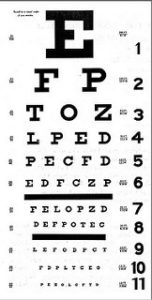Cataract

Normal Vision

The same scene as viewed by person with cataract
Source: National Institutes of Health (NIH)
OVERVIEW

A cataract is a clouding of the lens in the eye that affects vision. You may notice that your vision is blurred a little, like looking through a frosty or fogged-up window.
Types of cataracts include:
- Age-related cataract. This type of cataract is related to aging. This is the most common type and affects elderly above the age of 65.
- Congenital cataract. Some babies are born with cataracts or develop them in childhood, often in both eyes. This type of cataract develops as a result of an infection, injury, or poor development before they were born.
- Secondary cataract. Cataracts can form after surgery for other eye problems, such as glaucoma. Cataracts also can develop as a result of other medical conditions, such as diabetes, ultraviolet light, certain drugs (such as corticosteroids or diuretics), or exposure to toxic substances.
- Traumatic cataract. This type of cataract can form after an eye injury, sometimes years later.
- Radiation cataract. This type of cataract can form after exposure to some types of radiation.
» view references
References:
1. WebMD. Cataracts and your eyes.
2. National Eye Institute (NEI). Facts About Cataract.
» hide references
CAUSES OF CATARACT
![]()
The lens functions much like a camera lens. It bends the light rays to focus objects onto the retina at the back of eye. From there, the image passes through the retinal cells, into the optic nerve, and finally to the back of the brain which process the images. The lens also adjusts the eye’s focus, letting us see things clearly both up close and far away.
The lens is mostly made of water and protein. The protein is arranged in a precise way that keeps the lens clear and allows light to pass through it.
But as we age, some of the protein may clump together and start to cloud a small area of the lens. This is a cataract, and over time, it may grow larger and cloud more of the lens, thus preventing light from passing through the lens, causing some loss of vision.
The risk of cataract increases as you age. Other risk factors for cataract include:
- Nutritional deficiency – low levels of antioxidants (e.g. carotenoids – lutein & zeaxanthin, vitamin C and vitamin E)
- Certain diseases (e.g. diabetes, high blood pressure, obesity)
- Personal behavior (e.g. smoking and heavy alcohol consumption)
- Prolonged exposure to sunlight
- Family history of cataracts
» view references References: » hide references
1. Mayoclinic. Cataracts.
2. WebMD. Cataracts and your eyes.
3. National Eye Institute (NEI). Facts About Cataract.
Cataracts usually form slowly and cause few symptoms until they noticeably block light. The most common symptoms of cataracts are:
- Vision that is cloudy or blurry
- Fading or yellowing of colors
- Headlights, lamps or sunlight may appear too bright
- Seeing “halos” around lights
- Double vision or multiple images in one eye (like a superimposed image)
- Poor night vision
- Frequent changes in glasses and contact lenses prescription
At first, the cloudiness in your vision caused by cataracts may affect only a small part of the eye’s lens and don’t disturb your eyesight early on. But with time, cataracts grow larger and cloud more of your lens and distort the light passing through the lens. This may lead to signs and symptoms you’re more likely to notice.
Age-related cataracts can affect your vision in two ways:
- Clumps of protein reduce the sharpness of the image reaching the retina.
The lens is mostly made of water and protein. When the protein clumps up, it clouds the lens and reduces the light that reaches the retina. The clouding may become severe enough to cause blurred vision.
When a cataract is small, the cloudiness affects only a small part of the lens. You may not notice any changes in your vision. Over time, the cataracts may grow larger and cloud more of the lens, making it even more difficult to see through. Your vision may get duller or blurrier.
- The clear lens slowly changes to a yellowish/brownish color, adding a brownish tint to vision.
As the clear lens slowly colors with age, your vision may gradually acquire a brownish shade. At first, the amount of tinting may be small and not cause a vision problem. Over time, increased tinting may make it more difficult to read and perform other routine activities. This gradual change in the amount of tinting does not affect the sharpness of the image transmitted to the retina.
If you have advanced lens discoloration, you may not be able to identify blues and purples. You may be wearing what you believe to be a pair of black socks, only to find out from friends that you are wearing purple socks.
» view references References: » hide references
1. National Eye Institute. Facts About Cataract.
2. Drugs.com. Cataracts.
Cataracts can be diagnosed through a comprehensive eye exam that includes:
- Visual acuity test. This eye chart test measures how well you see at various distances.

Snellen Visual Acuity Chart
Source: National Eye Institute
- Dilated eye exam. Drops are placed in your eyes to widen, or dilate, the pupils. Your eye care professional uses a special magnifying lens to examine your retina and optic nerve for signs of damage and other eye problems. After the exam, your close-up vision may remain blurred for several hours.
- Tonometry. An instrument measures the pressure inside the eye. Numbing drops may be applied to your eye for this test.
- Refraction to determine the need for changes in an eyeglass or contact lens prescription.
- Evaluation of the lens under high magnification and illumination to determine the extent and location of any cataracts.
- Supplemental testing for color vision and glare sensitivity.
Your eye care professional also may do other tests to learn more about the structure and health of your eye.
» view references
References:
1. National Eye Institute. Facts About Cataract.
2. American Optometric Association Cataract.
» hide references
Though there is controversy about whether cataracts can be prevented, doctors think several strategies may be helpful, including:
 |
Taking nutritional supplement Many studies have shown that Lutein and Zeaxanthin reduce the risk of chronic eye diseases, including cataract and age-related macular degeneration (AMD). Antioxidant properties of vitamins C and E may also protect against the development and progression of cataracts. |
 |
Managing other health problems Follow your treatment plan if you have diabetes or other medical conditions that can increase your risk of cataracts. |
|
|
Having comprehensive eye examinations Helps to detect if you are at risk or detect it at their earliest stages. |
 |
Quitting cigarettes if you smoke Smokers are two to three times more likely to develop cataracts compared with non-smokers. |
|
|
Reducing alcohol consumption Excessive alcohol use can increase the risk of cataracts. |
|
|
Wearing sunglasses and a wide brim hat Helps to block ultraviolet rays when you are outdoors. Ultraviolet light from the sun may contribute to the development of cataracts. |
» view references
References:
1. Mayo Clinic. Cataract.
2. American Optometric Association. Nutrition and Cataract.
» hide references
The treatment of cataracts is based on the level of visual impairment they cause.
When symptoms begin to appear, it may be improved with new eyeglasses, brighter lighting, anti-glare sunglasses or magnifying lenses. New eyeglass prescription may provide temporary improvement in visual acuity. Brighter lighting when reading may be beneficial. The use of anti-glare coating on lenses can help reduce glare for night-time driving.
When a cataract progresses to the point that it impairs your vision and interferes with your everyday activity, such as reading, driving, watching TV, surgery may be needed. Cataract surgery involves removing the clouded lens and replacing it with an artificial lens. The artificial lens requires no care and can significantly restore vision. New artificial lens options include those that simulate the natural focusing ability of a young healthy lens.
» show more
Two types of cataract surgery are generally used:
- Phacoemulsification, or phaco. A small incision is made on the side of the cornea, the clear, dome-shaped surface that covers the front of the eye. Your doctor inserts a tiny probe into the eye. The probe emits ultrasound waves that soften and break-up the lens so it can be removed by suction. This process is also called “small incision cataract surgery”.
- Extracapsular surgery. Your doctor makes a larger incision in the cornea and the lens core is removed in one piece. The rest of the lens is removed by suction.
After the natural lens has been removed, it is replaced by a clear artificial lens called an intraocular lens (IOL). An IOL is a clear, plastic lens. Light is focused clearly by the IOL onto the retina, improving your vision. You will not feel or see the new lens.
For situations where implanting an IOL is not possible because of other eye problems or have problems during surgery, contact lenses and in some cases eyeglasses that provides high magnification may be an option to provide needed vision correction.
As with any surgery, cataract surgery has risks, such as infection and bleeding. Cataract surgery also slightly increases the risk of retinal detachment. It is important to discuss the benefits and risks of cataract surgery with your eye care professional and make sure cataract surgery is right for you.
References:
1. American Optometric Association. Cataract.
2. National Eye Institute. Facts About Cataract.
» show less




